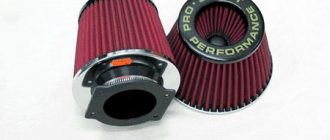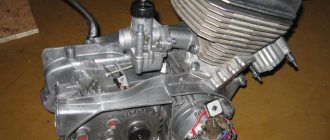Speakers with a diameter of 10 inches are considered the most convenient for small sound systems. This size allows you to place the subwoofer in the luggage compartment of any car. Speakers 25 centimeters are installed in a box of any design.
The box for 10-inch subwoofers can be either hermetically sealed or bass reflex. The simplest design to manufacture is the closed type. For a 25 cm speaker, the average volume of the box should be 15 liters. It is not worth doing less than 10 liters, as the low frequencies will be too “hard” and the bass will not be rich. If the internal volume of the box exceeds 20 liters, the sound will lose clarity.
Quarter wave (QW) in simple words
Do not be alarmed by the clutter of these words, we will not delve into the theoretical foundations of the quarter-wave resonator or quarter-wave resonator here, as it is usually called. Let's consider this type of design from the user's point of view, because CV has important advantages and few disadvantages.
In short, a quarter wave is a tunnel of a certain length and cross-sectional area; there are no separate concepts of housing and port, as we are used to in a bass reflex. If there is free space, it is very simple to calculate and does not have any special difficulties in manufacturing.
Main advantages of CV:
- reduced degree of group delay, well-developed bass and detail, sometimes exceeding a closed box;
- wide and smooth frequency range - with the right approach, the upper and lower bass can be easily mastered;
- increased level of efficiency, 20–40% more than that of bass reflexes or bandpasses and 150–300% than that of a closed box.
Just a cheater building - that's how it is! There is only one minus, but a significant one - the large volume of the box.
In other words, if you don’t mind space, then the HF will be the best choice for subwoofer design.
ChV calculation
The cross-sectional area of the port depends on the size of the speaker.
In words it means that the cross-sectional area of the port is one and a half effective area of the subwoofer.
It is important to know that the effective area (Sd) is not calculated by the standard size (10″, 12″, etc.), it is always smaller since the basket and part of the suspension do not participate in the radiation. Manufacturers often indicate this value in the documentation, but if there is no data, you can use the table:
Effective subwoofer area by size
also calculate Sd
Sd —effective subwoofer area, cm²;
where D is the diameter in centimeters, taken through the center from the middle of the suspension.
For a square subwoofer, calculating the area is even simpler - you need to square the length of one side.
Effective area of subwoofers
Accordingly, the port area is calculated as follows:
— cross-sectional area of the port, cm²;
The CV setting depends on the length of the port and is calculated as follows:
— port length, m.
Fb – desired tuning frequency, Hz
The optimal range is 35–45 Hz, no one forbids setting it low, if you like infra, lower the setting.
Calculation example
For example, let's calculate the frequency response with a setting of 38 Hz for a 12-inch (30 cm) speaker.
S port = 1.5 * 480 (from the table for 12″) = 720 cm²
In order for the box to fit into the car, the port is rolled up.
Box for URAL (Ural) AK-10
Subwoofer URAL (Ural) AK-10 is quite good in its characteristics and parameters. The boxes for it are very simple and not complicated.
A “closed box” for the URAL (Ural) AK-10 requires 25-30 liters, which is a rather modest figure.
Drawing of the ZYa box for URAL (Ural) AK-10.
A “closed box” for two URAL (Ural) AK-10 will require a volume of 50 liters. For two URAL (Ural) AK-10 this is the optimal volume
Drawing of the ZYa box for two URAL (Ural) AK-10
The bass reflex requires a little more, only 35 liters. The frequency response is quite smooth, the efficiency is 2-3 times greater than the “Closed Box”, very good!
As the volume of the FI box increases, the efficiency also increases, but the frequency response is very distorted, which has a very negative effect on the sound quality. Therefore, I think that the volume of 35 liters is the most suitable for this subwoofer speaker.
Frequency response FI box 35L 38Hz for URAL (Ural) AK-10
Drawing of FI box 35L 38Hz for URAL (Ural) AK-10
Drawing of a FI box 35L 38Hz with a port on the side (with a port on the wing) for URAL (Ural) AK-10
Drawing of FI box 35L 38Hz on 110 pipe for URAL (Ural) AK-10
Fi box for two URAL (Ural) AK-10 should have a volume of 70 liters and a port setting of 38 Hz.
Drawing of a FI box 70L 38Hz for two URAL (Ural) AK-10.
Drawing of a FI box 70L 38Hz with a port on the side (with a port on the wing) for two URAL (Ural) AK-10.
Drawing of a FI box 70L 38Hz on a 160 pipe for two URAL (Ural) AK-10.
Types of CV
Above we analyzed the calculation for a quarter-wave of constant cross-section, but there are also tapering and expanding tunnels.
If sound quality comes first for you, then make a HF with a tapering design. It is larger and more complex to manufacture, but the result is a bass that is accurate, fast and deep. This case is suitable for systems focused on sound quality! Unlike the classic direct HF port, the port is made to gradually taper from 3 Sd to 1.5 Sd at the outlet.
The expanding port will give the highest efficiency and loudness due to the humpback frequency response.
A tapering port will be shorter than the opening for the same setting. See the table for calculated data:
Port length depending on the type of CV
Purpose, design and principle of operation of the CV box
The design of the HF box is aimed at modulating the sound flow. The effect of sound transmission and reflection is used. Thanks to the special housing design, sound harmonization is achieved. This is especially noticeable at low frequencies and when installing a subwoofer. With the appropriate dimensions, the HF box will make the bass sound quite loud, bright, but unusually deep.
Subwoofer box
What types of subwoofer boxes are there?
There are several types of subwoofer boxes. you get at the output directly depends on the design of the box Below are the most popular types of subwoofers:
A closed box is the easiest to manufacture and design; its name speaks for itself. The woofer is housed in a sealed wooden housing, which improves its acoustic performance. Making a subwoofer in a car with such a housing is quite simple, but it has the lowest efficiency.
A 4th order bandpass is a type of subwoofer whose body is divided into chambers. The volumes of these chambers are different; in one of them there is a speaker, and in the second there is a bass reflex (air duct). One of the features of this type of subwoofer is the design's ability to limit the frequencies that the cone reproduces.
The 6th order bandpass differs from the 4th order by the presence of another bass reflex and another camera. There are two types of 6th order bandpasses - the first has one bass reflex, and the second has two (one of them is common to both cameras). This type of box is the most difficult to design, but produces maximum efficiency.
A bass reflex is a subwoofer with a special tube in the housing. It vents air and provides additional sound from the rear of the speaker. In terms of complexity in manufacturing and sound quality, this type is a cross between a closed box and a bandpass.
If you want to get the highest quality sound, you can opt for bandpasses. But this type of design has many details that must be carefully designed and calculated. All this can be done using a special program WinlSD, which will not only determine the optimal size and volume of the subwoofer, but also create a 3D model of it, and also calculate the dimensions of all parts.
Unfortunately, this program requires at least minimal knowledge in this area and the average car enthusiast is unlikely to be able to do everything right the first time. Moreover, in order for the program to work correctly, it needs some speaker parameters, which are also not known to everyone. If you do not plan to take part in car audio competitions, we advise you to discard the bandpasses.
Are you interested in auto tuning? Detailed instructions for installing parking sensors with your own hands especially for you!
Do you know what tiptronic is? Read the article about the pros and cons of this gearbox.
A bass reflex will be the most optimal solution for a homemade subwoofer. This type of box is good because the tube (bass reflex) allows you to better reproduce the lowest frequencies. In fact, this is an additional sound source that contributes to the sound of the subwoofer and increases efficiency.
Purpose and use
In a certain context, this device can be compared to an analog-type sound processor. Now that the purpose is clear, let’s now look at the design, operating principle and calculations. The proposed solution is especially in demand among motorists who want to install high-quality sound on used cars; with some effort, it will not be inferior to expensive audio systems.
So, in the technical understanding, the FM box, as implied by the name, is a resonator. We are talking about a hollow structure with the help of which sounds of a given frequency are reproduced. One of the functions of the resonator is to enhance audio sound. Such a device in the car will allow you to listen to loud music, provide musical accompaniment in nature, or use it for commercial purposes, for example, for scoring weddings and celebrations. The most popular solution is a box for a 12-inch speaker.
What materials do we need to assemble the subwoofer?
The material for making the subwoofer box must be durable, dense and well insulating sound. Multilayer plywood or chipboard is perfect for this . The main advantages of these materials are their affordable price and ease of processing. They are quite durable and provide good sound insulation. We will make a subwoofer from 30 mm thick multilayer plywood.
To make a subwoofer box we will need:
- Wood screws (approximately 50-55 mm, 100 pieces)
- Soundproofing material (Shumka)
- Drill and screwdriver (or screwdriver)
- Jigsaw
- Liquid Nails
- Sealant
- PVA glue
- Carpet, approximately 3 meters
- Klemnik
Assembling a subwoofer box with your own hands
You can start assembling. We use a 12-inch Lanzar VW-124 speaker.
Its diameter is 30 cm, and the first thing you need to do is cut a hole for the speaker. The minimum distance from the center of the diffuser to the subwoofer wall is 20 cm. We measured 23 cm (20 cm + 3 cm plywood width) from the edge of the panel and cut a hole with a jigsaw. Next, we cut a hole for the bass reflex slot; in our example, it has a size of 35*5 cm.
Instead of a slot, you can use a classic air duct - a tube. Now we assemble the bass reflex slot and attach it to the front panel of the subwoofer. We go along the joints with liquid nails and tighten them with self-tapping screws.
Next, we assemble the side walls of the box, having previously lubricated them with liquid nails, and tighten them tightly with self-tapping screws.
On the back cover of the box you need to cut a small hole for the terminal block. We connect all parts of the body. We make sure that we cut and fastened all the parts correctly.
We insert the speaker. Let's look and admire.
Let's move on to the interior decoration of the box. The first thing you need to do is seal all the joints and cracks with epoxy glue or sealant. Next, using PVA glue, we glue soundproofing material onto the entire inner surface of the box.
Now we cover the entire outer plane of the box with carpet, including the bass reflex slot. You can attach it with epoxy glue or using a furniture stapler.
Next, insert and screw the speaker tightly. The subwoofer is almost ready, all that remains is to stretch the wires from the speaker to the terminal block and connect the amplifier.
We bought an additional amplifier, but you can also make it yourself. This is quite difficult, as it requires knowledge and practice in the field of radio engineering. You can also use ready-made kits and circuits for radio amateurs, like Master-KIT, and assemble the amplifier yourself. The only requirement for the amplifier is that its maximum power must be less than the maximum power of the speaker .
See also a video report on making a homemade subwoofer for 2 speakers
Operating principle
Motorists may be familiar with a resonator, another example of which is the CV box For example, it is used as a functional element of a muffler. In this case, the hollow structure has its own characteristics and another purpose.
From a technical point of view, a resonator is an oscillatory system that accumulates vibrations due to frequency resonance. Typically, the design involves “working” with a limited set of frequency characteristics. Depending on the design, resonators of cumulative and instantaneous action differ.
Homemade wooden box
The storage resonator accumulates external energy by reducing the frequency of internal oscillations. In a mathematical context, any resonator design whose oscillation frequency is greater than the oscillation frequency of the external influence is cumulative. This happens whether the diameter is 10 or 12 inches, but you need to choose a different volume.
Instantaneous action implies the correspondence of the internal oscillatory force in period to external oscillations. Such resonators increase the sound power due to thermal absorption of the surrounding space, shifting the frequency at the input power - changes due to an increase in the playback interval.
The common CV box has a rectangular shape with partitions resembling a caterpillar in arrangement. The appearance will depend on the speaker and its features, size – 10″ or 12 inches. At the moment, you can find drawing diagrams for any frequency device and make a resonator at no extra cost. It will differ slightly from the brand name.
You can make a resonator in a mini version. This solution is shown in the figure.
Drawing of a CV box for 12″
To obtain drawings of 10, 12 and 15″ HF boxes, you can use a search engine or our resonator database or calculation program. The easiest way is to search by type of speaker and required volume. For example, a 12″ CV box can be implemented in several versions, depending on the technical features described and demonstrated below.
Making a stealth subwoofer with your own hands
Tired of carrying a huge box in your trunk? Then the stealth subwoofer is just made for you. This unique type of case is more practical than the classic box. It doesn't sit in a square box in the middle of the trunk and takes up less space. Often, stealth is installed in the inner part of the wing, sometimes in a niche instead of a spare wheel. The minimum volume of the box that requires a 10-12 inch speaker for normal operation is 18 liters.
To make a passive stealth subwoofer we will need:
- subwoofer;
- protective grille and socket for connection to the amplifier;
- wire for connecting the speaker to the outlet;
- multilayer plywood or chipboard (thickness 20 mm);
- a small piece of fiberboard;
- epoxy adhesive;
- brush;
- fiberglass;
- mounting tape;
- polyethylene film;
- wood screws;
- drill, jigsaw.
Find out what documents are needed to replace your license when changing your last name, and whether you need to take your license again.
Have you recently bought a new car? Read tips on breaking in a new car from experienced motorists.
Here /avtotovary/pokupka-avto/byudzhetnye-krossovery.html you can learn how to properly use and care for an automatic transmission.
After choosing the place where the stealth will be installed, we empty the trunk and begin manufacturing the body. You can remove the trunk trim where the subwoofer will be installed to place it even closer to the fender. First of all, lay a plastic film on the floor of the trunk. It performs two functions at once: it protects the trunk lining from epoxy glue and allows us to make a mount to which we will screw the bottom of the subwoofer. Next, we cover the inside of the wing with mounting tape in two layers.
We cut the fiberglass into small pieces, approximately 20x20 cm. We place pieces of fiberglass onto masking tape and glue them with epoxy glue. It is better to overlap the fiberglass fabric so that there are no obvious joints and seams.
We sculpt layers of fiberglass on top of each other, simultaneously lubricating them with epoxy glue, until the thickness of the sheet reaches 10 mm (about 4-5 layers).
The material will harden in approximately 12 hours. To speed up the process, you can use a lamp. Now we cut out the bottom of the subwoofer and glue it to our body. The joint is treated with sealant or glued with epoxy resin.
In this particular case, the shape needs to be adjusted to the trunk hinges so that our homemade subwoofer does not interfere with its closing. After we cut off all the excess, we cut out the side walls and the top cover from chipboard. We make the rounded part from plywood, we did it “by eye”.
How to calculate a resonator for the Urals yourself?
First of all, we note that the main material for making this audio device is multi-layer moisture-resistant plywood. The speaker input is sized according to the selected model. The volume and design will depend on the technical tasks: interior features, required power and other features.
Designs depending on the direction of the port
The figure shows that the direction of the port and other parameters also influence the design. Sometimes drivers, after making calculations, are concerned that the dimensions are very large compared to the available space in the cabin, so they recommend a design that is suitable for this task.
Other housing options
The photo shows an example of the calculation of the HF box, but in total the cross-sectional area of the tunnel is taken into account (for example, 10″ or 12″), depending on the caliber of the subwoofer, for example, Machete m10d2.
Example
Use the Quarter Wave Box calculation program. You will only need to enter the speaker parameters and box volume. Otherwise you will have to make the drawings yourself.
To do this, use ready-made recommendations - a table with subwoofer sizes for 10, 12 inches and others. The cells show the volume that needs to be taken as a basis to achieve certain audio parameters. A “tuning” is also selected depending on the machine owner’s preferences and frequency. The box can be designed for two or more speakers, they can be different 10″ or 15″.
The proposed variations demonstrate some solutions for organizing a car interior media system that are available for self-production. With a little effort, you will get a high-quality sound system in your car for your new Machete m10d2 or Ural, taking into account the features of your interior and preferences.
Before you start planning and building the box, you need to decide on the selection of the subwoofer itself. We recommend that you choose ten to twelve inch subwoofers, because they are most often used in the construction of boxes and are best suited to them. The structure of the box is also of significant importance: the quality and volume of low-frequency sound directly depends on it. At the moment there are several options for speaker boxes. The main thing is to make the right choice, because the sound quality will depend on it.
Types of subwoofer boxes
How to calculate the volume of a box for a speaker
- An 8" (20 cm) speaker requires 20-33 liters of net volume
- For a 10-inch (25 cm) subwoofer you will need 34-46 liters
- For a 12-inch (30 cm) subwoofer – 47-78 liters
- For 15-inch (38 cm) speaker – 79-120 liters
- And for an 18-inch speaker (46 cm) you will need 120-170 liters.
Box for 12 subwoofers with bass reflex
To build the box we will need:
- Dense multi-layer plywood or chipboard
- Self-tapping screws
- Screwdriver or screwdriver
- PVA glue
- Carpet
- Sound insulation materials
- Wires and terminal block
Cover the inside of the box with sound insulation. Before screwing in the screws, use a thin drill to mark holes so that the plywood does not burst. Assemble the structure, cut out the carpet with a margin to bend along the edges. Apply glue, let dry, and staple.










